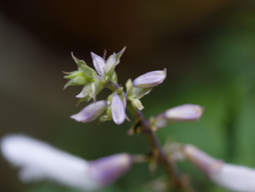Ethanol Extraction Of Salvinorin-A
Looking for a safe and effective way to extract Salvinorin-A from Salvia Divinorum? Our guide covers everything from selecting the right solvent to purifying the extract, and includes best practices for minimizing risks and ensuring quality.
Salvinorin-A is a potent psychoactive molecule found in the leaves of the Salvia divinorum plant, a member of the mint family. It has a unique chemical structure, belonging to the neoclerodane diterpene family, and is known to bind selectively to the kappa opioid receptor (KOR) in the brain.
Pharmacology
The chemical formula of Salvinorin-A is C23H28O8, and it has a molecular weight of 432.47 g/mol. It contains several functional groups, including an ester (COO) group, two ketone (C=O) groups, and several hydroxyl (-OH) groups. The molecule also contains a fused 5/6/7/5-ring system and an epoxide (C-O-C) group, which is believed to be essential for its binding to the KOR receptor.
Pharmacokinetics
In terms of pharmacokinetics, Salvinorin-A has a short half-life of approximately 30 minutes, and it is rapidly metabolized by the liver through hydrolysis and oxidation pathways. It is not active when taken orally due to its poor bioavailability, and therefore it is typically consumed via inhalation (smoking or vaporizing) or sublingual (under the tongue) administration. The extract you create here can be used sublingually. Ethanol extract of Salvia divinorum can be consumed sublingually, which involves placing the extract under the tongue and allowing it to be absorbed into the bloodstream through the mucous membranes. When consumed sublingually, Salvinorin-A from Salvia divinorum ethanol extract can produce a rapid onset of psychoactive effects within minutes, with peak effects occurring within 5 to 10 minutes. The duration of the effects can vary, but typically lasts for about 30 minutes to an hour.
Extracting Salvinorin Alpha from Salvia Divinorum Leaves
The extraction process involves using a solvent such as ethanol to dissolve the Salvinorin-A from the plant material. Here are the general steps involved in the ethanol extraction of Salvinorin-A from Salvia divinorum:
Ethanol Extraction
Steps
- Obtain Salvia divinorum leaves: You can purchase Salvia divinorum leaves from a reputable vendor or grow the plant yourself.
- Grind the leaves: Grind the leaves into a fine powder using a mortar and pestle or a blender.
- Measure the powder: Measure out the desired amount of Salvia divinorum powder to be extracted.
- Prepare the solvent: Ethanol is a commonly used solvent for Salvinorin-A extraction. Use food-grade ethanol (95-99% ethanol) to prepare the solvent. You can also use isopropyl alcohol or another suitable solvent, but ethanol is the safest option.
- Mix the solvent and powder: Place the Salvia divinorum powder into a glass container and add the ethanol solvent. The ratio of solvent to powder depends on the desired potency of the extract. A typical ratio is 100 ml of solvent per 10 grams of plant material.
- Stir the mixture: Stir the mixture for several hours, using a magnetic stirrer or by hand, to ensure complete extraction of the Salvinorin-A.
- Filter the mixture: After stirring, filter the mixture through a coffee filter or a funnel lined with filter paper to remove the plant material.
- Evaporate the solvent: Use a rotary evaporator or a heat bath to evaporate the ethanol solvent, leaving behind a concentrated Salvinorin-A extract.
- Purify the extract: Purify the extract by recrystallization or chromatography to remove impurities and obtain pure Salvinorin-A.
- If the means are available to you, analyze the purity: Use analytical techniques such as high-performance liquid chromatography (HPLC) or gas chromatography-mass spectrometry (GC-MS) to analyze the purity of the Salvinorin-A extract.
Recrystalization and Purification:
- Dissolve the Salvinorin-A extract in a suitable solvent, typically ethanol or methanol, at a high temperature to create a concentrated solution.
- Cool the solution slowly to promote the formation of crystals. This can be done by placing the solution in a refrigerator or an ice bath.
- Filter the solution to remove any remaining impurities or non-crystalline material.
- Wash the crystals with a small amount of cold solvent to remove any remaining impurities.
- Dry the purified crystals under vacuum to remove any remaining solvent.
Recrystallization process for Salvinorin-A ethanol extract in simple terms.
Materials needed
- Salvinorin-A ethanol extract
- Ethanol or methanol (solvent)
- Glass beaker or flask
- Hot plate or stove
- Stir bar or stirring rod
- Filter paper or coffee filter
- Funnel
- Weighing scale
- Glass stirring rod
Steps
- Measure out the amount of Salvinorin-A ethanol extract you wish to purify and record its weight.
- Place the Salvinorin-A ethanol extract into a glass beaker or flask.
- Add a suitable amount of ethanol or methanol to dissolve the Salvinorin-A ethanol extract. The amount of solvent used should be enough to fully dissolve the Salvinorin-A ethanol extract, but not so much that it becomes diluted.
- Heat the solution on a hot plate or stove until it reaches a gentle boil. Be sure to use a temperature setting that is not too high to prevent the solvent from boiling too vigorously and potentially boiling over.
- Stir the solution continuously with a glass stirring rod or stir bar to ensure that the Salvinorin-A ethanol extract is fully dissolved.
- Once the solution has reached a gentle boil, remove it from the heat and let it cool slowly to room temperature. Do not disturb the solution during the cooling process to allow the crystals to form.
- As the solution cools, crystals should begin to form. You can also scratch the bottom of the beaker or flask with a glass stirring rod to initiate the formation of crystals.
- Once the solution has reached room temperature and crystals have formed, filter the solution through a filter paper or coffee filter placed in a funnel to separate the crystals from the remaining liquid. Be sure to place a container under the funnel to collect the filtered liquid.
- Wash the crystals with a small amount of cold solvent to remove any remaining impurities that may have been carried over during filtration.
- Collect the crystals on the filter paper or coffee filter and allow them to dry under a fume hood or in a well-ventilated area until all the solvent has evaporated.
- Once the crystals are fully dry, weigh the purified Salvinorin-A crystals and record their weight.
Congratulations, you have successfully purified Salvinorin-A ethanol extract by recrystallization!
Sublingual use of Salvia divinorum ethanol extract is considered a safer method of consumption compared to smoking or vaporizing the plant material, as it avoids the potential harm to the respiratory system associated with inhalation. However, the effects of Salvinorin-A can be intense and unpredictable, and it is important to use caution and start with a low dose when consuming the extract sublingually.
The sublingual use of Salvia divinorum ethanol extract is not recommended for individuals with a history of mental health disorders or those taking medications that affect the central nervous system, as the psychoactive effects can be potent and may exacerbate underlying conditions. It is always advisable to consult with a healthcare professional before using any psychoactive substance, including Salvia divinorum ethanol extract, especially if you have any pre-existing medical conditions or are taking medications.
Safety and Precautions
Performing chemistry work and ethanol extraction of plant material like Salvia Divinorum requires adherence to specific safety precautions to avoid potential hazards. Here are some safety precautions to keep in mind:
-
Wear appropriate personal protective equipment (PPE): When working with chemicals, wear appropriate PPE such as lab coats, safety glasses, and gloves. This helps to protect your skin and eyes from contact with chemicals and solvents, which can cause skin irritation, burns, or blindness in extreme cases.
-
Work in a well-ventilated area: Many chemicals and solvents can produce harmful vapors, and it is important to work in a well-ventilated area to avoid inhaling these vapors. If possible, use a fume hood or work outside.
-
Use proper storage containers: Store chemicals and solvents in properly labeled containers and keep them away from heat sources and ignition sources. Flammable chemicals and solvents like ethanol should be stored in a flammable storage cabinet.
-
Be aware of fire hazards: Ethanol is highly flammable, and it is important to avoid open flames or sparks in the vicinity of the solvent. Do not smoke or use electronic devices near the solvent.
-
Follow proper handling procedures: Follow proper handling procedures when working with chemicals and solvents. Avoid splashing or spilling chemicals, and do not taste or smell them. Wash your hands thoroughly after handling chemicals or solvents.
-
Dispose of waste properly: Dispose of chemicals, solvents, and plant material waste properly, following all local regulations and guidelines. Do not pour chemicals down the drain or dispose of them in the trash.
-
Have a first aid kit on hand: Have a first aid kit on hand in case of accidents or chemical exposure. Know the location of emergency eyewash stations, showers, and fire extinguishers.
By following these safety precautions, you can minimize the risks associated with chemistry work and ethanol extraction of plant material like Salvia Divinorum.


































